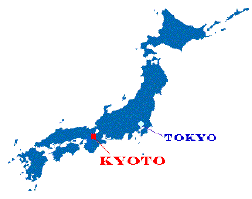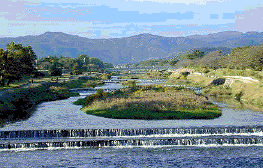

 | The City of Kyoto was founded as "Heiankyo" in 794 A.D. It flourished as the capital of Japan for approximately 1,000 years and was the birth site of the quintessential Japanese culture and traditions one finds throughout the country today. Even after the transfer of the capital to Tokyo with the Meiji Restoration in 1868, Kyoto maintained its position as Japan's cultural capital. It is home of various national treasures worthy of global pride as well as many historical buildings and traditional arts and crafts. Kyoto is known as the "spiritual home of the Japanese" and it is often said that without knowing Kyoto, it is impossible to grasp the true essence of Japan. |
| Kyoto's rich and colorful history, combined with its geographic and climatic factors, has created a city with a very unique blend of tradition, culture, and industry. Kyoto was laid out in a grid pattern with the Imperial Palace located at its center. The city was modeled on Chang-an (modern-day Xian), the capital of the Tang Dynasty of China. The surrounding areas are named according to their positions relative to the Imperial Palace: Rakuchu for central Kyoto, Kitayama for northern Kyoto, Higashiyama for eastern Kyoto, and Nishiyama for western Kyoto. The Kamo River which flows from north-south through the middle of the city serves as a useful reference point. The areas alongside the river bank have been developed into parks, walking trails, and playing fields. Thus, the riverside is a favorite spot of both citizens and visitors to relax within the city. |
 The Kamo River |
City Bus (within Kyoto city)
The fares are different according to whether you use a standard fare bus or a numbered ticket bus (seiri-ken-sha). For a standard fare bus, the fares are 220 yen for adults and 110 yen for children. If you get on a numbered ticket bus, be sure to take a numbered ticket out of the machine as you board. The fare is different according to the number on your ticket and will be shown above the exit door as you leave. How to use the city bus: Get on the bus at the rear door, and put the fare in cash into the fare box next to the driver's seat when you get off. If you take a numbered ticket bus, take the ticket (seiri-ken) from the machine placed at the rear door. Put it into the fare box with cash (or a bus ticket that can be purchased in advance) as you leave. To request the bus to stop, press a buzzer near you.
Subway (Underground Train)
Fare: 200-320 yen for adults, 100-160 yen for children. How to use the subway: There are two subway lines: Karasuma and Tozai. Buy a ticket for your destination from the vending machine, and go through the automatic ticket entrance to board a train. Go through the ticket again as you leave.
Although rainfall is rare in July, the weather is hot and humid with an average temperature during the day of 31.3 C and 72% humidity.
Loose-fitting, cool clothes are recommended for walking outside, but it is best to carry a light jacket, or similar, since the conference site, hotels and most shops and restaurants are air-conditioned.
- Av. daytime high 31.3 C° (88.3 F)
- Av. nighttime low 22.7 C° (72.9 F)
- Av. humidity 72%
- Days with more than 10 mm rainfall 6.4 days